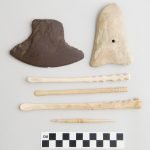1902
Kittigazuit
Kitigaaryuit is an important Inuvialuit heritage site, where one group of Inuvialuit ancestors (the Kitigaaryungmiut) lived for at least 500 years. While Kitigaaryuit was occupied year-round, hundreds of people would travel there from the surrounding area to participate in the highly organized beluga whale hunt; making Kitigaaryuit the largest known seasonal gathering place in the Canadian Arctic. Many of those hunters and their families spent the whaling season at the village site of Kitigaaryuk which non-Inuvialuit called Kittigazuit, and the area is still used seasonally by Inuvialuit today.
Kitigaaryuit is where Sir John Richardson, a member of Sir John Franklin’s second Arctic expedition, first encountered Inuit. Additionally, it was the location of the first Hudson’s Bay Company trading post operated on the shorelines of western Inuit Nunangat. The remains of a log house and icehouse used by the Hudson’s Bay Company are still visible. The HBC and other traders encouraged the white fox fur trade which replaced the whale hunt as the economic driver in the area. In 1902, a devastating measles epidemic turned the village into a place of sadness and fear. The epidemic resulted in Kitigaaryuit having the largest concentration of traditional driftwood graves in the Beaufort Delta Inuit. The area fell out of use as a whaling station and became an Anglican mission from 1911 to 1917.
Because of the cultural significance of the village and surrounding area, the abundance of archaeological remains present at the site and the commanding view of the Mackenzie River available from its shores, Kitigaryuit was formally recognized as a Canadian National Historic Site on June 19th, 1978. The site was listed on the Canadian Register of Historic Places on December 30th 2009, where it is referred to as the “Kittigazuit Archaeological Sites.”


